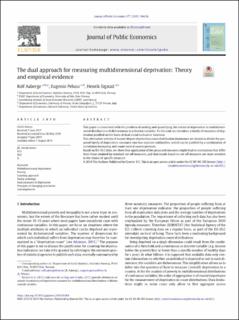| dc.contributor.author | Aaberge, Rolf | |
| dc.contributor.author | Peluso, Eugenio | |
| dc.contributor.author | Sigstad, Henrik | |
| dc.date.accessioned | 2020-02-14T13:59:44Z | |
| dc.date.available | 2020-02-14T13:59:44Z | |
| dc.date.created | 2019-10-24T19:26:32Z | |
| dc.date.issued | 2019 | |
| dc.identifier.citation | Journal of Public Economics (2019), 177 (September), 104036 | en_US |
| dc.identifier.issn | 0047-2727 | |
| dc.identifier.uri | https://hdl.handle.net/11250/2641800 | |
| dc.description.abstract | This paper is concerned with the problem of ranking and quantifying the extent of deprivation in multidimensional distributions of dichotomous deprivation variables. To this end, we introduce a family of measures of deprivation justified on the basis of dual social evaluation functions. Two alternative criteria of second-degree deprivation count distribution dominance are shown to divide the proposed family of deprivation measures into two separate subfamilies, which can be justified by a combination of correlation increasing and count neutral rearrangements. Based on EU-SILC data, we show that application of the proposed measures might lead to conclusions that differ from those attained by standard cut-off measures, and that results based on cut-off measures are more sensitive to the choice of specific measure. | en_US |
| dc.language.iso | eng | en_US |
| dc.publisher | Elsevier | en_US |
| dc.rights | Navngivelse-Ikkekommersiell 4.0 Internasjonal | * |
| dc.rights.uri | http://creativecommons.org/licenses/by-nc/4.0/deed.no | * |
| dc.subject | Multidimensional deprivation | en_US |
| dc.subject | Poverty | en_US |
| dc.subject | Fattigdom | en_US |
| dc.subject | Counting approach | en_US |
| dc.subject | Dual measures of deprivation | en_US |
| dc.title | The dual approach for measuring multidimensional deprivation: Theory and empirical evidence | en_US |
| dc.type | Peer reviewed | en_US |
| dc.type | Journal article | en_US |
| dc.description.version | publishedVersion | en_US |
| dc.rights.holder | © 2019 The Authors. Published by Elsevier.
This is an open access article under the CC BY-NC-ND license.
https://creativecommons.org/licenses/by-nc-nd/4.0/ | en_US |
| dc.subject.nsi | VDP::Samfunnsvitenskap: 200::Økonomi: 210 | en_US |
| dc.source.pagenumber | 12 | en_US |
| dc.source.volume | 177 | en_US |
| dc.source.journal | Journal of Public Economics | en_US |
| dc.source.issue | September | en_US |
| dc.identifier.doi | https://doi.org/10.1016/j.jpubeco.2019.06.004 | |
| dc.identifier.cristin | 1740400 | |
| dc.relation.project | Norges forskningsråd: 261985 | en_US |
| dc.relation.project | The project received financial support from the Research Council of Norway (grant number 261985). | en_US |
| cristin.unitcode | 5932,3,0,0 | |
| cristin.unitcode | 5932,0,0,0 | |
| cristin.unitname | Avdeling for person- og sosialstatistikk | |
| cristin.unitname | Statistisk sentralbyrå | |
| cristin.ispublished | true | |
| cristin.fulltext | postprint | |
| cristin.qualitycode | 2 | |

